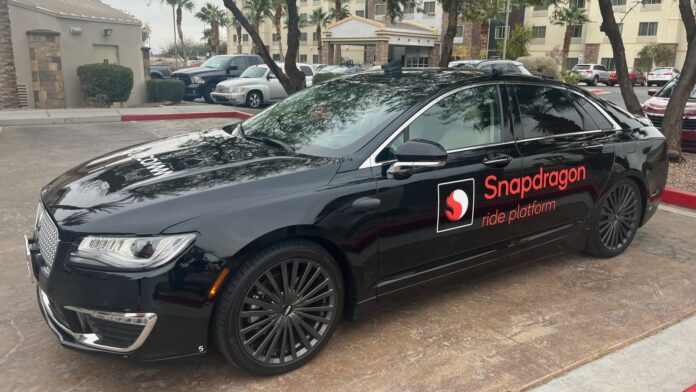LAS VEGAS—Qualcomm’s latest(Opens in a new window) improvement to its car-focused platform is the Snapdragon Ride Flex SoC (System-on-Chip), which will power both digital cockpit features, such as multiple integrated displays and voice technology, and advanced driver assistance systems and autonomous driving.
That means more vehicles on the road with automatic braking, lane keeping assist, adaptive cruise control, assisted parking, and autonomous driving. The Snapdragon Ride Flex SoC is set for production starting in 2024, so it should arrive in vehicles in the following years.
Car makers like BMW(Opens in a new window) and GM(Opens in a new window) already use Qualcomm’s Snapdragon platform, which was announced(Opens in a new window) in 2020. “We are making it easier and more cost effective for automakers…to embrace our pre-integrated suite of software solutions with an accelerated time-to-market advantage,” says(Opens in a new window) Nakul Duggal, SVP and GM of automotive at Qualcomm Technologies.
Hitting the Road
How autonomous is Qualcomm’s technology? We took a test drive in a Lincoln MKZ equipped with Snapdragon Ride driving technology. This was not the new chip, as it’s not in production yet—and we were not permitted to take any photos or video during the actual test drive—but it was a good check-in on where the technology is at this point and the state of autonomous driving.
Self-driving cars need a special ‘autonomous vehicle’ tag, noted at the base of the license plate.
(Credit: Emily Dreibelbis)
Let’s go autonomous driving!
(Credit: Emily Dreibelbis)
Qualcomm had pre-programmed a route for the 15-minute drive. A safety operator sat behind the wheel and initiated autonomous driving as soon as we got on the highway. Qualcomm told me the vehicle is classified as “Level 2+”—which apparently(Opens in a new window) sits between Level 2 (partial automation) and Level 3 (conditional automation) on a scale from Level 0 to Level 5.
I sat in the passenger seat, next to a screen that showed the vehicle on the road as it drove, as well as the surrounding cars its cameras could detect. (It looked very similar to Tesla’s AI visualization(Opens in a new window).) In the back seat, an engineer monitored the data as the car drove along. “We’re always testing and looking for new driving scenarios,” he said. “There are so many.”
The vehicle successfully merged lanes, sped up/slowed down in response to other cars, and got on and off the highway by itself. It felt much more autonomous than just simple lane keeping or smart cruise control, which most new cars have these days. It was thrilling to see the car drive itself in a real-world scenario, and I felt safe.
Recommended by Our Editors
That said, it required an operator to initiate self driving at the appropriate time and to monitor it. There were a few times he had to intervene, even with straightforward highway driving scenarios that did not appear uniquely stressful or complex. In the end, the demo had the same “so close, yet so far” feeling that has plagued autonomous driving for years.
Tesla has also struggled to successfully bring autonomous driving to market. Its heavy investment in AI for level 4 and level 5 autonomous driving has been met with lawsuits and fatal crashes involving Teslas equipped with its $15,000 “self-driving” software update. This led California to ban Tesla from calling its technology “self-driving.”
The fact that Qualcomm is working on a rival product will hopefully create a compelling competitor, accelerate the development of autonomous driving technology, and bring it to non-Tesla drivers. But based on what we saw at CES, it too is a work in progress.
Get Our Best Stories!
Sign up for What’s New Now to get our top stories delivered to your inbox every morning.
This newsletter may contain advertising, deals, or affiliate links. Subscribing to a newsletter indicates your consent to our Terms of Use and Privacy Policy. You may unsubscribe from the newsletters at any time.
Hits: 0














